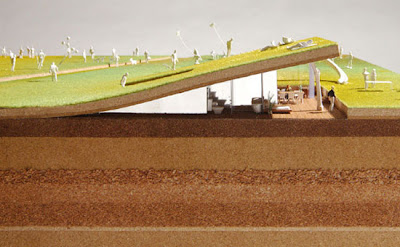Veg.itecture in Visual Assessment (VIVA) continues with some amazing examples (and not to mince word, there are shitloads of them on the web). Perhaps a trend, perhaps overexposed, or perhaps we’ve finally reached the point where we’ve transcended the original and just become purveyors of the mundane. A quick snippet of the amount of blog posts showing vegetation on buildings is a good indication of the ho-hum attitude we take towards this still fascinating phenomenon. It perhaps is a bit more fascinating due to it’s ubiquitiousness.
So onward, with wild abandon. To start, a building with origins in fantasy, the ‘house in never never land’, andrés jaque architects offers honest-to-goodness physical models of building. Check out this > 30% preview comes via Designboom.

:: images via Designboom
WAN features the Nya Årstafältet masterplan, ‘Arkipelag’ in Stockholm, Sweden – with a variety of green roofs – designed by archi5.

:: images via WAN
Inhabitat features a trio of green roofed skyscrapers in Taiwan, by NBBJ Architects.

:: image via Inhabitat
Some Sim-City looking imagery from the roof gardens on plans for Project Green, in Austin, Texas.

:: images via Urban Greenery
Another land-based green roof is for the Asian Culture Complex by architect Kyu Sung Woo is located in Gwangju, South Korea. (via Designboom)

:: images via Designboom
a-lab designed the Statoil Hydro office in Oslo, Norway with some rooftop greenery.

:: image via WAN
And a literal vegetated ‘tree hotel’ by Tham + Videgard Hansson Arkitekter in Harads, Sweden.

:: images via Dezeen
Nothing like ‘green carpet’ to elucidate the ‘green carpet house’ by hiroshi nakamura and NAP architects. A tilted up panel of vegetation extends site to roof.

:: images via Designboom
A very popular entry in the pantheon, the “Shenzhen 4 Tower in 1” Master Plan by Steven Holl has made the rounds lately – due to it’s incorporation of many veg.itectural concepts. You name it, it’s in there – Vertical Gardens, Roof Gardens, Stormwater and Greywater Collection… as well as a Public Park (via SpaceInvading).

:: images via SpaceInvading
Veg.itect jean nouvel has designed the ‘C1’ building which offers a rooftop greenhouse (via Designboom)

:: images via Designboom
Morphosis ends with a vegetated rooftop (via Inhabitat) for a building in China for the ‘Giant Campus’ which is at least some vibrant subtlety (albeit blase renderings) amongst some of the craziness.

:: images via Inhabitat











There are definitely some positive synergies between solar and green roof – as the vegetation keeps the panels cooler – making them work more efficiently at an optimal, cooler temp. Another I hadn’t thought about was what you mentioned – particularly if they clean the solar panels in the summer when there is less water – it can limit the irrigation needed for keeping the green roofs viable. I’d expect to see more of this in the future as more people are seeing the benefits of both – and not thinking of it as an either-or issue.
It’s pretty noticeable and great to see that green roofs have become commonplace in the last couple years. The “cutting edge” designers seem to have moved on to green walls, which personally I am more skeptical of. They seem very material and labor intensive for what you get back, when you put them on a building. Maybe I’ll like them better when I see more; a lot of people were wrongly skeptical of green roofs.
Indeed Ryan. It’s interesting to see the evolution from innovation to fad to last year’s news… the funny part is, we’ve barely begun to scratch the surface in North America about what works and what is the overall potential of green roofs – for stormwater, heat island, habitat, roof longevity, and energy efficiency – but everyone seems to thing you can paint green on a roof and it will just work. The item du jour may be green walls, but there’s still a lot of work to do in the realm of veg.itecture to get it all right.